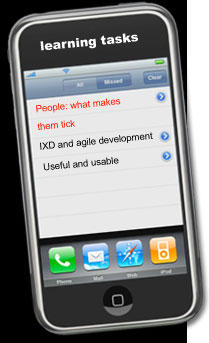Many influences (approx 10 minutes)
Iteraction design draws on a wide range of areas that have an already established body of knowledge about understanding people. Explore what some of these are.
- Group Brainstorm:
- From your reading about Interaction design list the disciplines that you think informs its practices and principlesd.
-
Review the list Moggridge (2007) suggests (in links).
- how is this similar or different to your list
- Are there areas that you identified that were not in the reading?
- Record using a table to show the differences between your two lists.
NOTE: It is recommended that you now divide and conquer with the following three activities: 2or 3 people should do cognition; 1or 2 people should do Social Frameworks; and 1or 2 people should do Emotion.
Step 5 helps you bring it all together.
Cognition - its up there for thinking (approx 40 minutes)
Interaction design draws some of its knowledge from studies of cognition (especially Cognitive Psychology): ie what goes on inside people’s heads.
- Norman (1993) describes two general modes of cognition: experiential cognition and reflective cognition.
- Cognitive Processes: Cognition has been described in terms of a range of processes: attention, perception & recognition; memory; learning; reading,
speaking & listening; and problem-solving, planning reasoning, decision-making.
- Cognitive Frameworks: A number of cognitive frameworks have also shaped what interaction designers do. These include: mental models, theory of action, information processing, external cognition, and distributed cognition
- Use your analyses to develop a list of design principles from this cognitive research
- This list will contribute to your company’s design principles.
Social frameworks - people just don't operate in their head! (approx 40 minutes)
Humans are inherently social: they live together, work together, learn together, play together, interact and talk with each other, and socialize.
-
Three social mechanisms are identified in your text Preece etal (2002, 2007) that are central to social interactions: conversation, co-ordination and awareness.
-
Explore each of the processes in the Preece etal (2002, 2007) text
- Note the general characteristics of each
- Use the social mechanism summary and powerpoint to help you with your reading.
- Create a list of design principles appropriate for communication and collaboration purposes using digital products. Where are these likely to be most useful:
- the Interaction Design website
- the ePortfolio project you have been tasked to design?
- the potential mobile project you may be working on?
You should have a list that you can use to contribute to the design principles of your company.
Emotion - a significant design influence (approx 30 minutes)
In the last few years the affective aspect of computing – that is the emotional response people have to using a computer, has gained more attention.
- Your emotional response to the computer
- Brainstorm a list of emotional responses you may have had using a computer
- Categorise them as fun, enjoyable or frustrating.
- Compare your list with the discussion in Preece etal (2002, 2007)
- Three models of user experience are influencing digital product design in the twenty-first century:
-
Norman’s Emotional Design model developed 1999
- Jordan’s Pleasure model developed 2000
-
McCarthy & Wright’s Technology Experience Framework developed 2004
-
Using your text and links provided, review the main ideas in each model
- Develop some design principles regaring a positive user experience.
Your company's design principles (approx 20 minutes)
NOTE: It is recommended that the whole group completes Step 5 and shares ideas found in the three proceeding steps.
You have now reviewed readings the help you understand the cognitive, social and emotional aspects of the people for whom you are creating technological products.
Its time to bring this together in a meaningful way:
- Share the understandings that you have found
- What is cognition and cognitive processes and how do they impact on design?
- What are some cognitive frameworks that have impacted on how you think about designing for people?
- What are the social mechanisms that need to be considered if you are designing communication/ collaboration tools?
- What are the emotional aspects to consider in design and how do these impact on a product?
- Create a list of design principles that will be the hallmark of your company
- Organise these under three headings: cognitive, social, emotional
- Add these principles on your website

![]()

